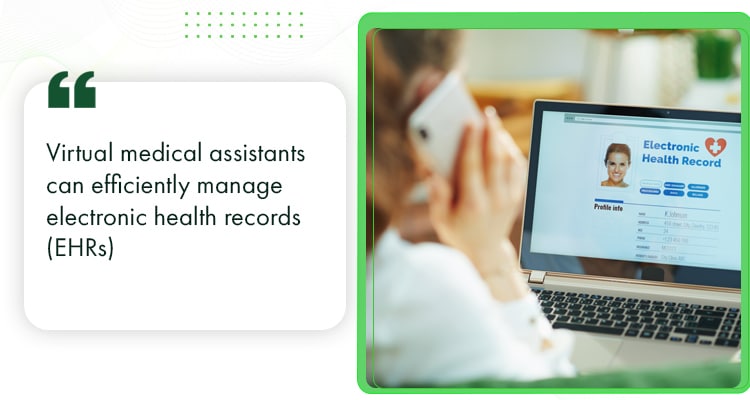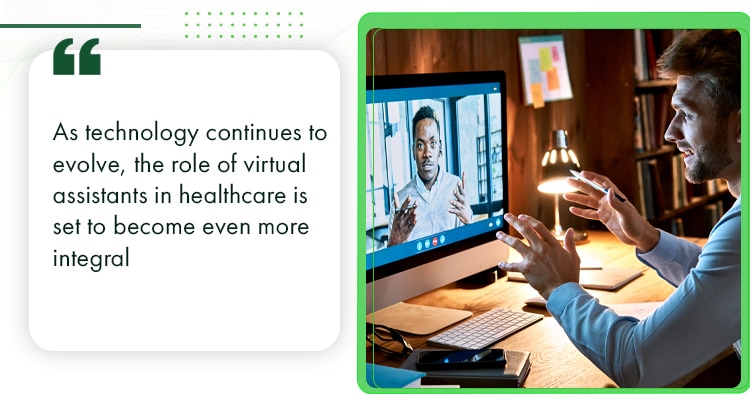The Role of a Virtual Medical Assistant in Transforming the Healthcare Industry
In recent years, the healthcare industry has witnessed a significant transformation, largely driven by technological advancements.
One of the most impactful innovations in this sector is the emergence of virtual medical assistants.
These digital helpers are revolutionising the way healthcare providers operate, as virtual medical assistants enhance patient care and streamline administrative tasks.
This article explores the multifaceted role of virtual medical assistants or virtual healthcare assistants and their profound impact on the healthcare industry.
What is a Virtual Medical Assistant and How Do They Operate?
A virtual medical assistant is a remote professional who provides administrative, technical, and sometimes clinical support to healthcare providers.
Unlike traditional in-office assistants, virtual medical assistants work remotely, leveraging technology to perform their duties efficiently and effectively.
Understanding the Role of Virtual Assistants in Healthcare
Virtual assistants in healthcare serve as a bridge between patients and medical professionals, ensuring a seamless connection with virtual patient services.
They utilise various digital platforms and tools to manage office tasks that traditionally required physical presence, allowing proficient virtual medical assistants to enhance productivity in the medical office.
This shift has allowed healthcare providers to focus more on patient care while ensuring that administrative duties are handled promptly and accurately.
Key Responsibilities of a Medical Virtual Assistant
The responsibilities of a medical virtual assistant are diverse and can include:
- Managing patient appointments and schedules
- Handling patient inquiries and providing information
- Processing medical billing and insurance claims
- Maintaining and updating electronic health records
- Transcribing medical notes and reports
- Coordinating with other healthcare professionals
- Assisting with telemedicine consultations
- Verifying patient insurance coverage
- Ordering prescriptions as directed by physicians
- Following up on patients’ test results
- Managing medical records
- Facilitating communication between patients and healthcare providers
- Conducting patient intake and registration
- Performing medical coding tasks
- Managing inventory and ordering supplies
- Handling email correspondence
- Conducting healthcare research and literature reviews
- Managing social media accounts for healthcare practices
- Assisting with remote patient monitoring (RPM)
- Providing virtual receptionist services
- Conducting patient satisfaction surveys
- Assisting with medical documentation and charting
- Preparing and generating various practice operation reports
- Conducting pre-authorisation for medical procedures
- Assisting with patient education and providing resource
Differences Between In-House and Virtual Medical Assistants
While both in-house and virtual medical assistants support healthcare practices, there are key differences:
- Location. In-house assistants work on-site, while virtual assistants work remotely.
- Availability. Virtual assistants often offer extended hours of support to ensure that virtual patient needs are met around the clock.
- Cost-effective. Solutions are essential for practices looking to hire virtual assistants to efficiently manage their workload. Virtual assistants typically have lower overhead costs for the practice.
- Scalability. It is a significant benefit of utilising medical virtual assistant services in a growing healthcare practice. Virtual assistant services can easily scale up or down based on practice needs.
- Technology. Virtual assistants rely heavily on digital tools and platforms.

How Virtual Medical Assistant Services Enhance Patient Care
Virtual medical assistant services have significantly improved patient care in several ways.
By taking over time-consuming administrative tasks, they allow healthcare providers to dedicate more time to direct patient care.
This increased focus on patients leads to better health outcomes and improved patient satisfaction.
Moreover, virtual assistants facilitate better communication between patients and healthcare providers.
They can quickly respond to patient inquiries, provide timely reminders for appointments and medications, and ensure that patients have access to their health information when needed.
Why Should You Hire a Virtual Medical Assistant?
Benefits of Hiring Virtual Medical Assistants for Your Medical Practice
Hiring a virtual medical assistant can bring numerous benefits to your healthcare practice:
- Increased Efficiency. Virtual assistants can handle multiple tasks simultaneously, reducing bottlenecks in your practice’s workflow.
- Extended Availability. With virtual assistants, your practice can offer support to patients beyond regular office hours.
- Reduced Overhead Costs. By eliminating the need for physical office space and equipment, virtual assistants help reduce operational costs.
- Scalability. As your practice grows, virtual assistant services can easily scale to meet increased demands.
- Improved Focus on Core Medical Services. By delegating administrative tasks, healthcare providers can concentrate on delivering quality medical care.
Cost-Effectiveness of Virtual Assistant Services
One of the most compelling reasons to hire a virtual medical assistant is the cost-effectiveness of their services.
Traditional in-office assistants require salaries, benefits, office space, and equipment. In contrast, virtual assistants typically work on a contract basis, eliminating many of these expenses.
This arrangement allows healthcare practices to access high-quality support at a fraction of the cost of full-time, in-house staff.
Improving Patient Satisfaction through Virtual Assistance
Virtual medical assistants play a crucial role in enhancing patient satisfaction.
They provide prompt responses to patient inquiries, ensure timely follow-ups, and facilitate smooth communication between patients and healthcare providers.
This level of attentiveness and efficiency contributes to a positive patient experience, leading to higher satisfaction rates and improved patient retention.
How Can Virtual Assistants Streamline Administrative Tasks?
Handling Medical Billing and Insurance Verification
Medical billing and insurance verification are complex and time-consuming processes that dedicated virtual medical assistants can simplify.
Virtual medical assistants can efficiently handle these tasks, ensuring accurate billing, timely submissions, and proper insurance verification.
This streamlined approach reduces errors, accelerates reimbursement processes, and improves the overall financial health of the practice.
Streamlining Appointment Scheduling and Patient Communication
Virtual assistants excel in managing appointment schedules and patient communications.
They can:
- Assist in various tasks that streamline medical office operations
- Schedule and reschedule appointments
- Send appointment reminders via text, email, or phone
- Handle cancellations and fill vacant slots
- Provide patients with pre-appointment instructions
- Follow up with patients post-appointment
This comprehensive approach to appointment management reduces no-shows, improves patient flow, and enhances the overall efficiency of the practice, showcasing how virtual healthcare can optimise operations.

Efficient Management of Medical Records
Maintaining accurate and up-to-date medical records is crucial for providing quality healthcare, and managing medical records is a key responsibility of virtual medical assistants in the medical office.
Virtual medical assistants can efficiently manage electronic health records (EHRs), ensuring that patient information is accurately recorded, easily accessible, and securely stored, thus facilitating better virtual healthcare.
This meticulous record-keeping supports better clinical decision-making and continuity of care.
What Are the HIPAA Regulations for Virtual Medical Assistants?
HIPAA (Health Insurance Portability and Accountability Act) regulations for virtual medical assistants require strict adherence to privacy and security standards when handling protected health information (PHI).
Virtual assistants must implement robust security measures, including encryption of electronic communications, secure access controls, and proper disposal of outdated records.
They must also sign a Business Associate Agreement (BAA) with healthcare providers, undergo comprehensive HIPAA training, and follow protocols for reporting potential data breaches.
Additionally, virtual medical assistants are responsible for maintaining detailed audit trails and ensuring that all their activities align with HIPAA’s stringent guidelines for patient data protection
Understanding HIPAA Compliance in Virtual Assistant Services
The Health Insurance Portability and Accountability Act (HIPAA) sets strict standards for protecting patient health information, which is critical for medical scribes and virtual assistants in the medical specialty.
Virtual medical assistants must adhere to these regulations to ensure patient data privacy and security.
This compliance involves implementing robust security measures, maintaining confidentiality, and following strict protocols for handling patient information.
The Importance of HIPAA Training for Healthcare Professionals
Healthcare providers must ensure that their virtual assistants receive comprehensive HIPAA training. This training should cover:
- Understanding of HIPAA regulations and their implications
- Proper handling of protected health information (PHI)
- Recognition and reporting of potential security breaches
- Best practices for maintaining patient confidentiality
Ensuring Patient Data Security with Virtual Medical Assistants
To maintain HIPAA compliance and protect patient data, healthcare practices should ensure that their virtual assistants are equipped with the knowledge of medical terminology.
- Use secure, encrypted communication channels.
- Implement multi-factor authentication for accessing patient records.
- Regularly audit and update security protocols to ensure that virtual healthcare practices remain compliant and secure.
- Establish clear guidelines for data handling and storage to ensure that virtual medical assistants can manage patient information effectively.
- Conduct regular security assessments and training.
How Can You Successfully Hire a Virtual Medical Assistant?

The Hiring Process: What to Look For in a Virtual Assistant
When hiring a virtual medical assistant, consider the following qualities:
- Experience in Healthcare. Look for candidates with a background in healthcare administration or related fields, especially those who understand the tasks ranging from patient management to telemedicine.
- Technical Proficiency. Ensure they are comfortable with various healthcare software and digital tools as dedicated virtual assistants handle these tasks efficiently.
- Communication Skills. Strong written and verbal communication skills are essential for effective communication with your virtual assistants and healthcare providers.
- Attention to Detail. It is crucial when virtual assistants offer support in managing patient information. Medical tasks require precision and accuracy, which is why virtual medical assistants can help streamline processes.
- Time Management. The ability to juggle multiple tasks efficiently is crucial.
- HIPAA Compliance. Familiarity with HIPAA regulations is a must for any virtual medical assistant providing medical assistance.
Building a Productive Working Relationship with Your Virtual Assistant
To foster a productive relationship with your virtual medical assistant provider:
- Establish clear communication
- Clearly define roles and expectations
- Establish regular communication channels
- Provide necessary training and resources through a training program to ensure virtual assistants can perform their roles effectively
- Set measurable goals and performance metrics
- Offer constructive feedback and recognition
Common Job Roles of a Medical Virtual Assistant
Medical virtual assistants can fill various roles, including:
- Virtual Medical Scheduler
- Virtual Patient Care Coordinator
- Remote Medical Billing and Coding Specialist
- Virtual EHR Management Assistant
- Remote Medical Transcriptionist
- Virtual Healthcare Liaison
- Telemedicine Support Specialist
- Virtual Insurance Verification Specialist
- Remote Prescription Management Assistant
- Virtual Patient Follow-up Coordinator
- Digital Medical Records Manager
- Virtual Patient Communication Specialist
- Remote Patient Intake Specialist
- Virtual Medical Coder
- Remote Medical Supply Coordinator
- Virtual Healthcare Correspondence Manager
- Remote Healthcare Research Assistant
- Virtual Healthcare Social Media Manager
- Remote Patient Monitoring Assistant
- Virtual Medical Receptionist
- Remote Patient Satisfaction Analyst
- Virtual Medical Documentation Specialist
- Remote Healthcare Operations Analyst
- Virtual Pre-authorisation Specialist
- Remote Patient Education Coordinator
What Future Trends Are Emerging for Virtual Assistants in Healthcare?
The Rise of Remote Patient Monitoring
Remote patient monitoring is becoming increasingly prevalent, with virtual assistants playing a crucial role in virtual healthcare. They can:
- Monitor patient vital signs through connected devices
- Alert healthcare providers to significant changes in patient condition
- Facilitate virtual check-ins and follow-ups
- Manage and analyse patient health data
Innovations in Healthcare Virtual Assistance
Emerging technologies are expanding the capabilities of virtual medical assistants:
- Artificial Intelligence. AI-powered assistants can provide more sophisticated support, including preliminary diagnoses and treatment recommendations.
- Natural Language Processing. Improved NLP allows virtual assistants to understand and respond to complex medical queries more accurately.
- Predictive Analytics. Virtual assistants can analyse patient data to predict health trends and potential issues, acting as a virtual health assistant in the medical specialty.
- Blockchain Technology. This can enhance the security and interoperability of health records managed by virtual assistants, providing virtual support to healthcare providers.
Impact of Technology on Virtual Assistant Solutions
Technological advancements are continually reshaping virtual assistant solutions in healthcare:
- 5G Networks. Faster, more reliable internet connections will enhance the capabilities of virtual assistants, especially in telemedicine and virtual support.
- Internet of Things (IoT). Integration with IoT devices will allow virtual assistants to collect and analyse more comprehensive patient data, enhancing the healthcare services provided.
- Augmented Reality (AR). AR could enable virtual assistants to provide visual guidance for medical procedures or patient education.
- Voice Recognition. Improved voice recognition technology will make interactions with virtual assistants more natural and efficient.

In conclusion, virtual medical assistants are transforming the healthcare industry by enhancing efficiency, improving patient care, and streamlining administrative processes.
As technology continues to evolve, the role of virtual assistants in healthcare is set to become even more integral, promising a future where healthcare is more accessible, efficient, and patient-centered than ever before.
The integration of virtual medical assistants represents a significant step forward in the ongoing digital transformation of healthcare, offering benefits to providers, patients, and the overall healthcare system.
- Want to streamline your business operations? Check out these 100 AI prompts.
- Looking for world-class remote workers to join your team? Click here.
- Experience the advantages of a top global team and check out our 1,000 fully vetted and highly talented staff here.
Darren Aragon is a multifaceted writer with a background in Information Technology, beginning his career in research at Pen Qatar and transitioning through customer service to a significant role at Absolute Service, Inc. His journey into freelance writing in 2021 has seen him excel across various niches, showcasing his adaptability and deep understanding of audience engagement.




















